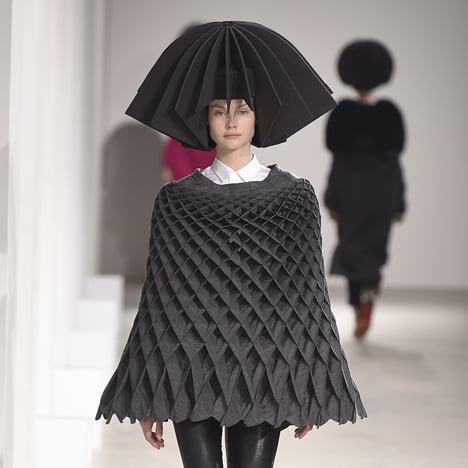Voluminous origami-influenced garments and headdresses featured in Japanese fashion designer Junya Watanabe's catwalk show during Paris Fashion Week.
The Junya Watanabe Autumn Winter 2015 presentation on Saturday was awash with folded three-dimensional forms, starting with connected pyramid-shaped structures that created monochrome dresses, tops and scarves.
As the show at Palais de Tokyo progressed, these shapes were exaggerated into longer spikes worn across the chest and shoulders.
Watanabe's label – part of the family of brands under Japanese fashion house Comme des Garçons – also showcased a selection of ponchos, dresses and capes made from fabric mesh.
To create the mesh, horizontal bands of material were stacked on top of each other and attached together at offset intervals that created honeycomb-shaped holes when pulled apart.
First shown in black and grey as larger nets, these garments were then presented with a tighter mesh in red, blue and camel.
Variations were created with vertically orientated strands, and most were worn over simple white shirts and loose trousers.
Different folding techniques were used to create more structural clothing, including a set that incorporated diamond-shaped patterns formed with the golden section – a mathematical sequence commonly found in nature.
These rigid sections were worn around the shoulders and arms as tops over long, colour-matched dresses, as well as used for ample skirts.
Shiny fabrics were also pleated into repeating curved profiles that continued right around the body, creating sculptural coats.
To accompany the garments, hats in domed, spherical and lampshade-like shapes were formed with vertical fins of material repeated around 360 degrees.
Some of the head pieces echoed the rounded silhouettes of the stiff garments they were paired with.
Models' hands, legs and chests were scrawled with algebraic equations for the runway show.
Other fashion designers that work with origami-like patterns include Issey Miyake, who has an entire range dedicated to pleats and also designed a collection of clothes that expand from two-dimensional geometric shapes into structured shirts, skirts, pants and dresses.
Miyake's head of womenswear also explained the brand's new technique for folding fabrics with nothing but steam in a recent interview with Dezeen.

